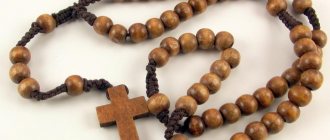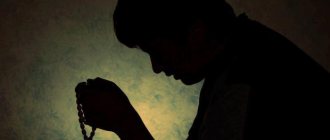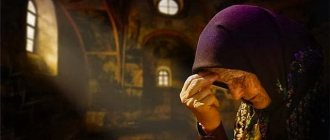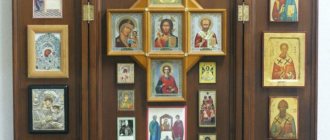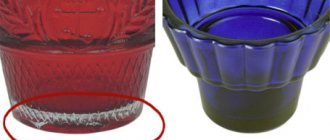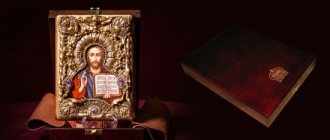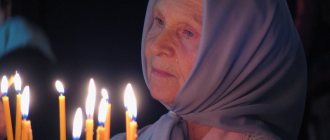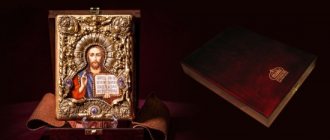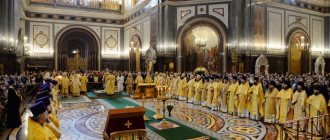"Save me, God!".
Thank you for visiting our website, before you start studying the information, please subscribe to our Orthodox community on Instagram, Lord, Save and Preserve † - https://www.instagram.com/spasi.gospodi/. The community has more than 60,000 subscribers. There are many of us like-minded people and we are growing quickly, we post prayers, sayings of saints, prayer requests, and timely post useful information about holidays and Orthodox events... Subscribe. Guardian Angel to you!
You can often see the following picture: a person saying a prayer is fingering something in his hands. They look like beads strung on a thread. They are called rosaries. It must be remembered that this is an instrument of prayer, and not an aesthetic detail.
About the rosary
The name “rosary,” according to V. Dahl, comes from the words: count, honor (count), thus denoting a device for counting - a string of beads or a belt with knots - for counting prayers and bows. Leather rosaries are called lestovka. Externally, the rosary is nothing more than balls (cloth, glass, amber, wood, etc.) strung on a cord and topped with a cross. The ladder is a round belt, which instead of a cross has four paws, and between them there are seven sliders and nine leather steps and 100 so-called “butterflies” (or another option – “bobbins”). The purpose of the ladder coincides with the rosary, also serving to count prayers and bows; it has been preserved in the everyday life of Old Believers and fellow believers, although it is not forbidden to use it in our Church. In some images (for example, on the famous icon of prayer on a stone) the ladder is visible in the hand of St. Seraphim. According to church tradition, the prototype of the ladder was a rope - a rope loop with knots tied on it, which served to count the number of Jesus prayers. Therefore, its other name is rosary, that is, a device for counting. The rosary was introduced into use by Saint Basil the Great (according to other sources - by Pachomius the Great and even by Saint Anthony, but in any case - a very long time ago, in the first centuries of Christianity) for illiterate monks who followed the prayer rule not according to books, but according to a certain number of Jesus prayers . They had no other purpose - neither practical nor symbolic. Here in Rus', the rope turned into a ladder - a stairway to heaven. Its parts - steps - are called: “earth”, “sky”; all parts received important symbolic meaning; From a simple device for counting, the rope turned into the most important instrument of prayer.
The lestovka is a woven leather (or, in later times, rag or dermantine) ribbon sewn in the form of a loop. It symbolizes both the ladder (ladder) of spiritual ascent from earth to heaven and a closed circle, an image of eternal and unceasing prayer. A ladder is used to make it easier to count prayers and bows, allowing you to focus on the prayers. The device of the ladder meets the practical needs of worship (for example, when saying prayers 40 or 12 times), but at the same time it has a symbolic interpretation. There are 100 simple steps on the tape, called “bobs”. In addition, there are three more steps at the beginning, three at the end and three “great” steps in the middle, which collectively mean the nine ranks of angels. The beginning and end of the ladder are marked by intervals without steps, symbolizing heaven and earth. The “great” steps divide the staircase into four unequal sections: from the “ground” to the first great step – 12 steps, which means 12 apostles. From the first great step to the second inclusive – 40 steps. This means a 40-day fast of the Lord Jesus Christ. There are 33 steps to the third great step, meaning 33 years of the Lord’s earthly life. After the third great step and up to “heaven” there are 17 simple steps, meaning 17 Old Testament prophecies about Christ. At the junction of the ends of the ribbon, four edged triangular “lapostki” (paws, sometimes palms) are sewn, which are often decorated with beads and embroidery. They mean the four evangelists, and the border is the gospel teaching. Under the paws there are slides - seven rectangles strung on a ribbon, according to the number of seven church sacraments. These movements also mean seven full steps, which every pious Christian must pray during the day. This practical significance of the movements - counting the number of sanded flaps - is absent in products of modern work, since the movements are made only symbolically, and the legs are often so tightly sewn together that the movements are difficult to reach.
In addition to the usual 109-step ladder, there are 150-step ladders, the so-called. "Virgin's ladders" They are of later origin and are made in the image of a Catholic rosary. In the Old Believers they have minimal distribution.
The production and artistic decoration of ladders was and remains one of the traditional Old Believer crafts. Monastic work was especially famous. Two ancient crafts are associated with the history of the Old Believers in the Semenovsky region (Nizhny Novgorod region), each of which has its own history. The now forgotten lestovochny craft can be considered an exclusively Old Believer craft. It undoubtedly appeared with the emergence of the schism in 1667, and perhaps earlier.
The making of lestovkas, or monastic rosaries, in the Old Believer communities in the city of Semenovo was carried out by a small number of families, only 10–15, no more, the work remained purely artisanal. The main material for the manufacture of ladders was locally produced leather “Yuftya”, and ordinary paper was used for the rollers. Various embroideries served as decoration, ranging from multi-colored yarn, beads and ending with gold. Interestingly, the purpose of ladders is very diverse. They were used not only when reading prayers. For example, during a wedding, those getting married must have rosary beads in their hands, and the most beautiful and expensive ones were used. Many schismatics gave lestovki along with various alms - money, bread, things, etc. The elders of the monasteries usually did not part with them for a minute; the lestovki also served them as a tool for punishing the “whites” instead of whips. (Whoever read the wonderful story “Pilgrim” by I. Shmelev can remember how much awe a leather ladder in the hands of a stern grandmother caused in a boy...) There were also mourning rosaries. The entire artisanal lestovka industry in the city of Semenov was supported by the merchant-philanthropist Nikolai Aleksandrovich Bugrov. He bought them in large quantities and distributed them to all the followers of “his faith”, i.e. to the Beglopopovites. Some of the lestovkas were distributed locally to merchants-charities, some were sold in Nizhny Novgorod, in Gorodets and at the Nizhny Novgorod Fair. Now you can get acquainted with this forgotten craft at the Semenovsky State Historical and Art Museum.
In the spiritual practice of the Orthodox Church, as a modern author (hieromonk Longin) notes, there is no strict rule on how to pray on the rosary. The main prayer prayed on the rosary is the Jesus Prayer: “Lord Jesus Christ, Son of God, have mercy on me, a sinner,” or shorter forms, the shortest of which is “Lord, have mercy on me.” In this short prayer, a person who has the experience of real deep prayer finds the fullness of prayerful requests, prayerful thanksgiving, and prayerful sighing. The rosary in monasticism is called the spiritual sword
and are given to the monk at the time of tonsure for unceasing prayer, for invoking the name of God as often as possible. In this case, the rosary is a tool (means) for reminding one of unceasing prayer, a means against distraction of the mind. The rosary can also be used for a special prayer rule, which consists of a certain number of Jesus prayers (centurion, two hundred, etc.). In this case, the rule is read with a special blessing, because otherwise you can fall into a state of spiritual delusion and seriously harm your spiritual work. Moreover, for ordinary lay people (non-monastics), the use of rosaries in prayer practice is possible only with the blessing of a confessor, and then more for a reminder of unceasing prayer than for a special prayer rule, although the latter is not excluded. Prayer on the rosary also does not exclude the possible insertion of other prayers, for example, on each large bead you can read “Our Father”, or “Rejoice to the Virgin Mary”, or some other prayer close to the person praying, or prayers in your own words that pour out from the heart of a person and which Orthodox spiritual practice does not prohibit, as long as the heart calls out to God. But in any case, any prayer practice requires the blessing of a confessor.
Prayer with the rosary should be invisible to prying eyes, with the exception of monastics who have a special blessing for this.
“When a newly tonsured monk is given a rosary, the following words are pronounced...: “Take, brother, the spiritual sword, which is the word of God, to the everlasting Jesus Prayer: for you must always have the name of the Lord Jesus Christ in your mind, in your hearts and in your mouth.” saying continually: Lord Jesus Christ, Son of God; have mercy on me, a sinner.” Here a saying from the Holy Scripture is used, the words of the Apostle Paul (see Eph. 6:17), giving the rosary a certain symbolic meaning: in this case they are called the “sword of the Spirit.” And this is a very fair and wise comparison, although the Apostle Paul did not refer these words to the rosary, not to the Jesus Prayer, but to the power of Christian preaching, which is the “spiritual sword.” But when we engage in the Jesus Prayer, we also preach the word of God, we preach the truth as if for ourselves, and we force all our mental and physical strength to submit to this gospel sermon. There is no contradiction here: indeed, the rosary we need to perform the Jesus Prayer seems to depict this spiritual sword striking invisible enemies. Everyone, more or less attentively, sincerely, diligently engaged in this matter - the Jesus Prayer, knows that in it we not only repent, ask God for mercy, forgiveness of sins and eternal blissful fate, but also at the moment of spiritual warfare, the uprising of demons against us them with it like some kind of sword. This is a real weapon with which we defend ourselves during attacks by enemies and strike ourselves. Therefore, it is very appropriate and reasonable that the rosary given to the newly tonsured person is symbolically called the spiritual sword.
Based on this comparison that already exists in church rites, we can dare to find other words, sayings, and narratives of the Holy Scriptures with which this amazing patristic invention is associated - the rosary.
First of all, the rosary brings to mind the Gospel story about (see Matt. 21:12 et seq.) how our Lord Jesus Christ, entering the Jerusalem temple, saw people there selling cattle, which were intended for sacrifices, and money changers who exchanged money (also as if for an important reason, because only special Jewish coins could be donated to God, and coins that belonged to pagan states, including the Roman one, were not suitable for this purpose - this was specifically stipulated in the law). And so the Lord was indignant that in the courtyard of the temple, where people were only supposed to pray, reverently standing before God, they were distracted from prayer by this trade and general vanity, completely inappropriate for a house of prayer. He began to overturn the tables of the money changers and, having made a scourge, as it is said in Slavic - a scourge from ropes (John 2:15), he began to drive out of the temple both the merchants themselves and the cattle that they were selling. You know that the Jewish temple consisted of courtyards, was in the open air, and only the “holy” and “holy of holies” (what is called the altar in our temples) were located in a separate building. So, the rosary is precisely associated with this scourge from the ropes, and this association, it seems to me, has a fairly serious justification, because by praying, we really drive away from our hearts, from our souls “traders” - all kinds of uncleanness - “cattle ", by which one can understand carnal passions; the body and spirit of man, according to the teaching of the Apostle Paul, is the temple of God (see 1 Cor. 3:16-17).
The rosary also reminds us of the Savior’s parable of the sower (Matt. 13:3–9). A plant that grew on rocky soil, had no root and withered from the heat of the sun, or one that died on the road, or one that was choked by thorns, can be likened to an incorrect, unreasonable prayer, from which a person ultimately receives no benefit. Correct exercise in prayer (and the most useful and fruitful is the unceasing prayer (of Jesus) can be compared to bearing fruit a hundred times over. And indeed, the rosary has a hundred knots in it, which seems to hint that if we diligently practice this by doing, we will receive a hundred times more fruits compared to the diligence that we put in.
We need all these comparisons related to the appearance of the rosary in order to arouse in ourselves zeal for practicing the Jesus Prayer. One can also find some similarity of the rosary - their knots, which are connected to each other - with the bonds of Christ imposed on our Lord Jesus Christ when He was taken in the Garden of Gethsemane, bound and led to a lawless trial, to suffering and shameful death - crucifixion. Therefore, while practicing the Jesus Prayer, we must remember with contrition the sufferings of the Savior, at least trying to imitate His humility shown in those terrible passionate days. And since the rosary is crowned with an image of a cross, then, most likely, this comparison is not in vain and not artificial, it helps to understand the meaning and inner meaning that lies in this beautiful object invented by the holy fathers. The Apostle Paul says: other things, let no one give me labor: for I bear the marks of the Lord Jesus in my body (Gal. 6:17). Of course, by the stripes of the Lord Jesus we mean the cross that the Apostle Paul, like every Christian, bore on himself. And on the rosary we also see the image of the cross, that is, the wounds of the Lord Jesus Christ, and, wearing them on our body (we carry them in our hand, which is also part of our body), we should not engage in any other work except to please the Lord, and especially the Jesus Prayer. This is the first and most important thing, and the rest, no one gives us work, because everything else is in vain, unnecessary or, at best, secondary. Thus, the very arrangement of the rosary in the form of connected knots, reminding us of the bonds of Christ, and the cross crowning the rosary, should remind us of Christ’s humility, with which we must perform this great work of the mind, doing the Jesus Prayer.
Finally, the cross ends with a tassel - the so-called “voskrili”; four such tassels ended the clothes of the ancient Jews, and these tassels reminded them that they must fulfill the commandments. And, of course, in this case, this brush should also remind us that prayer can only be successful and achieve its goal when, along with zeal in it, we also have zeal for fulfilling the commandments. But, in addition, this brush also reminds us of the resurrection of the robe of the Savior Himself. ...As the bleeding wife said to herself: if I just touch the sparkle of His garment, I will immediately be healed (See Matt. 21-22). And by her faith, she received what she asked for, that is, as soon as she touched the edge of the Lord’s robe, namely, the tip of the cry, she was healed from bleeding. So we must believe that only, so to speak, with a light touch to the grace of Christ, as if to this resurrection, to the hem of His robe, can we receive healing from the flow of passions that have tormented us, perhaps, for many, many years , if, of course, we touch this resurrection with faith, like a bleeding woman.
It may seem that all these are just external, artificially attracted images, which in reality have no relation to such a simple device - the rosary, but even if historically it appeared as a result of a confluence of some external circumstances, there can be nothing accidental in the Church. And therefore, the reasoning that touching the brush that is on the rosary symbolizes, as it were, an invisible touch of the mind to the hem of Christ’s robe, to the grace of God, is also not forced and artificial. We see that the rosary is arranged in the form of a closed circle, which, of course, without any artificiality, is easily associated in the mind with infinity, in this case with eternity. The Apostle Paul says: What is seen is temporary, but what is unseen is eternal (2 Cor. 4:18). And the rosary, this ingenious device invented by the holy fathers to help us engage in smart work, also reflects this invisible eternal. Being an outwardly simple object, they display many invisible, sublime things, as if revealing their presence for us during the Jesus Prayer. Let me list it again: firstly, the rosary is a spiritual sword that helps us in the battle with demons. Secondly, it is a scourge with which we drive passions out of our souls. Thirdly, this is a symbol, this is a consolation for us, showing that if we diligently and wisely practice the Jesus Prayer, we will receive a hundredfold reward. Fourthly, the rosary reminds us of the bonds and suffering of the Savior and, thus, teaches us humility. Fifthly, they teach us to remember the commandments and at the same time hope for the mercy of God, because just touching the glory of God and grace already heals us from the flow of passions. And, finally, they are an image and symbol of eternity, to which a person becomes familiar through the practice of prayer, especially through the practice of the unceasing Jesus Prayer.
The attitude towards the rosary should be reverent. They need to be in the same place where the Gospel and prayer book are kept.”
As one of the experienced practitioners of the Jesus Prayer, monk Boris, wrote at the beginning of the 20th century: “Do you want to learn how to quickly and forcefully drive away thoughts brought by demons? Drive them away when you are alone in your cell, with a loud, attentive prayer. Brother! Say her words on the rosary slowly, with tenderness: “Lord Jesus Christ, Son of God, have mercy on me, a sinner.”
The rosary indicates one hundred and ten knots (meaning a hundred with ten dividing knots). Separate ten large knots out of a hundred to create a prayer to the Mother of God. Pray to Her like this: “Most Holy Theotokos, save us all and me, a sinner.” And She will always be your Helper in everything.
My brother! Demons tremble from attentive verbal prayer, and their networks collapse! And the holy angels pray together with those who perform oral, attentive prayer, as some holy saints of God were worthy to witness this: St. Seraphim of Sarov, Simeon Divnogorets and others.
Throughout their lives, the holy fathers practiced oral and vocal prayer and received the gifts of the Holy Spirit. The reason for their success is that the mind, heart, whole soul and whole body were connected to the voice and lips; they said the prayer with all their souls, with all their strength, with all their being, with all their being. They were thus inflamed with love for God.
Brother! With God's help and the prayers of our Most Holy Theotokos, let us be attentive to the oral and public prayers we say during church services and in the solitude of our cells. My brother in Christ, we will not make our labors and life in the monastery fruitless by our inattention and negligence in the work of God.”
One of the elders of the 19th century says much more about the inner side of prayer: “The main thing is to become mind in heart before the Lord,” writes Bishop Theophan the Recluse (1815–1894), “and stand before Him without leaving day and night until the end of your life.” According to this definition, you can pray without asking for anything and even without uttering any words. The emphasis shifts from an action limited to a period of time to a lasting state. To pray means to stand before God in personal and direct communication; to know with all our being, both intuitively and rationally, both in the subconscious and in the superconscious, that we are in God and God is in us. Personal relationships between people do not become deeper because we constantly question and utter words. On the contrary, the better we know each other and the more we love, the less need we have to say how we feel about each other. Personal communication with God is built in exactly the same way.
“Prayer with invocation of the name, on the one hand, is extremely simple and accessible to every Christian, on the other, it leads into the mysterious depths of contemplation. Anyone who intends to read it every day and for a long time, and even more so to combine it with breathing or another bodily rhythm, must certainly find an experienced spiritual mentor, an elder, although this is very difficult to do these days. Those who do not have a personal connection with the elder can safely, without involving bodily rhythms, start small: ten to fifteen minutes of continuous prayer.
There is no need to learn the Jesus Prayer or prepare for it in advance. Advice for a beginner: just start. “If you don’t take the first step, you won’t walk, and if you don’t dive into the water, you won’t swim. It’s the same with calling the name. Begin with love and reverence and be persistent. Do not think about calling on the name, but only about standing before Jesus. Say the name slowly, quietly and calmly.”
Learning the words of prayer is not difficult. Most often it is pronounced like this: “Lord Jesus Christ, Son of God, have mercy on me.” But there is no uniformity here: sometimes “have mercy on me” is replaced with “have mercy on us” or the prayer is shortened to: “Lord Jesus Christ, have mercy on me” or even to “Lord Jesus”; finally – extremely rarely – to “Jesus”. Some, on the contrary, add “me, a sinner,” strengthening the repentant aspect of the prayer. Or, remembering the confession of the Apostle Peter on the road to Caesarea Philippi, they say “...Son of the Living God...”. Sometimes an appeal to the Mother of God or saints is inserted into the Jesus Prayer. But the Name “Jesus,” which is the essence of prayer, is always present in it. We can try different combinations of words and choose the one that suits us best. Once chosen, the formula can be changed over time, but not too often. “Just as plants do not take root if you replant them often, so do prayerful movements in the heart, with frequent changes of prayer words,” warns St. Gregory Sinait.
For prayer “according to the rule”, as for “free”, there are no strict rules. Body position doesn't really matter. In the Orthodox tradition, prayer is most often read while sitting, but you can also stand, kneel, and if you are overcome by infirmities or fatigue, then lie down. And, as a rule, in the dark or with eyes closed, and not in front of an icon illuminated by a lamp or candle. Elder Silouan of Athos (1866–1938), when he prayed, hid his watch in the closet so as not to be distracted by the ticking, and pulled a thick woolen monastic cap over his eyes and ears.
The darkness, however, has a soporific effect! If you feel sleepy during prayer, you need to get up from your knees or seat, make the sign of the cross after your petition and bow, touching the floor with your right hand. You can also bow to the ground - kneeling and touching your forehead to the floor. A seat for prayer should not be relaxing, much less luxurious; it is good if it has no handles. In Orthodox monasteries they usually use a low bench without a back. You can pray standing and raising your hands.
The Jesus Prayer is often recited through a rosary, usually with a hundred knots. They do this not so much in order to count, but in order to concentrate and maintain the rhythm. It is well known from experience that if the hands are busy, it is easier to calm the body and concentrate on prayer. Passion for quantitative assessments - using rosaries or otherwise - is by no means encouraged. In “Frank Tales of a Wanderer,” the elder strictly instructed how many times a day one must repeat the Jesus Prayer: first 3 thousand, then 6 thousand and finally 12 thousand, no more and no less. This is a completely unusual attention to quantity. Apparently, the point here is not just a matter of numbers, but of the inner disposition of the wanderer: the elder wanted to test his obedience and see if he was ready to fulfill everything he ordered him without hesitation. Bishop Feofan’s advice is more suitable for us: “You say that sometimes you forget the count of prayers on the rosary. The trouble is small. When one falls to the Lord, as if present, with fear and hope, this is better than any number of prayers.”
When calling on the name, there is no need to deliberately imagine the Savior. The Jesus Prayer is usually read without looking at icons, but in the dark or with eyes closed. “The memory of good and bad things usually imprints their images on the mind and leads it into daydreaming,” writes St. Gregory Sinait. “Then the one experiencing this is already a dreamer (phantasies), and not a silent person (hesychastes).” “And so as not to fall into delusion when doing mental prayer,” writes the Monk Nil of Sorsky († 1508), “do not allow any ideas, any images or visions in yourself.” “In the action of the Jesus Prayer there should be no image intervening between the mind and the Lord,” writes Bishop Theophan. – The essence of mental prayer is walking before God; and walking before God is the conviction that does not depart from consciousness that God is everywhere, so He is in you, and sees everything, even the inner, sees even more than we ourselves. This consciousness of the eye of God looking inside you should also not have an image, but everything should consist in one simple belief or feeling.” Only by calling on the name in this way—not by imagining the Savior, but simply by feeling His presence—will we experience the full power of the Jesus Prayer, which brings together and bestows wholeness.”
It can be noted that rhythmic speech, which is an integral attribute of the Jesus Prayer, according to secular researchers, has a healing effect. According to Italian scientists, it has a beneficial effect on the heart.
Experts examined the relative breathing rate of 23 people while praying with rosaries. The peculiarity of both of them was that their text, according to tradition, should be repeated fifty times. Or maybe three times that much. For comparison, breathing rhythms were measured during an ordinary conversation and during exercises to regulate breathing.
The normal human respiratory rate is about 14 units per minute, and this can be reduced to 8 in trained people. While reading Christian prayers, the breathing rate can decrease to 6 breaths per minute. Their effect on the body is similar: they help synchronize heart rhythms. And this, as cardiologists note, has a positive effect on a person’s cardiovascular activity.
“The Jesus Prayer is amazingly flexible. This is a prayer for beginners, but it also leads to the deepest secrets of the contemplative life. It can be practiced by anyone at any time: while standing in line, walking, riding a bus or train, working, during insomnia or in moments of great anxiety when it is impossible to concentrate on other types of prayer. However, of course, it is one thing for any Christian to say the Jesus Prayer in this way at some special moments, and another thing to say it more or less constantly, using the physical exercises associated with it. Orthodox spiritual authors insist that those who practice the Jesus Prayer systematically should, whenever possible, surrender to the guidance of an experienced mentor and not do anything on their own initiative.
For some, there comes a time when the Jesus Prayer “enters the heart,” so that it is no longer said as a result of conscious effort, but by itself. It continues even when a person is walking or writing, is present in his dreams and wakes him up in the morning.
Orthodox believe that the power of God is present in the name of Jesus, so that invoking the name of God acts as an effective sign of divine action imbued with sacred grace. “Prayer penetrates the inner being of a person who, in amazement, sees himself in the Divine light... The light of the name of Jesus, through the heart, illuminates the entire universe.” Both for those who read the Jesus Prayer constantly and for those who resort to it only occasionally, it is a source of boldness and joy. Let us quote the Wanderer (“Frank stories of a wanderer to his spiritual father”):
“Now I walk like this and constantly say the Jesus Prayer, which is more precious and sweeter to me than anything else in the world. Sometimes I walk seventy miles or more a day and don’t feel like I’m walking; but I only feel like I’m saying a prayer. When the strong cold grips me, I will begin to say my prayer more intensely and soon I will be completely warm. If hunger begins to overcome me, I will begin to call on the name of Jesus Christ more often and will forget that I was hungry. When I become sick, my back and legs begin to ache, I begin to listen to prayer and I don’t hear pain. Whoever insults me, I will only remember how delightful the Jesus Prayer is; Immediately the insult and anger will pass, and I will forget everything... Thank God! Now I clearly understand what the saying I heard from the Apostle means: “Pray without ceasing” (1 Thess. 5:17).”
Number of beads on Orthodox rosary
Modern rosary beads for Orthodox Christians are a closed chain of beads, most often strung on a woolen thread. How many should there be? The quantity varies, from ten to one hundred, or they contain 33 peas, according to the number of earthly years of the Savior.
Every ten beads serve as a reminder of the commandments of Christ and are separated by balls of different texture or size. This allows you to completely immerse yourself in prayer without getting lost in counting. The rosary is crowned with an Orthodox cross with the image of Christ, which reminds of humility and the call to perform spiritual deeds for good. Sometimes under the cross of Christ there is a thread tassel, which priests use to sprinkle holy water.
Is it considered a sin to drown kittens?
Stories from the lives of holy ascetics related to rosaries
On the death of Hierodeacon Serapion
The fact that the rosary is not just a mechanical device is also evidenced by a very interesting incident from the biography of one Glinsk ascetic, Hierodeacon Serapion. This ascetic, pious, zealous, who throughout his life avoided even ordination to the rank of hieromonk, despite the fact that he was worthy of it, asked that when he died, he would not be buried for three days. And so, when he died, the brothers saw an extraordinary miracle: after his death, when his body lay on his deathbed, he continuously fingered his rosary for three hours, and this showed his inner most sublime state - everything that was in his heart.
The meaning of rosaries for Orthodox Christians
Modern Orthodox Christians serve rosaries in the same way as they served their spiritual ancestors:
- A cord with beads will help you turn to God at any time. A reminder of continuous prayer with a sequence of words and actions.
- Maintaining attention and concentration. The tactile sensation of the beads helps the believer maintain the direction of the text.
- The rhythmic fingering of the rosary sets a certain pace and does not allow one to deviate from the prayer.
- Carrying a rosary with you allows you to turn to God anywhere.
- By the shape and number of beads, one can determine the degree of the owner’s affiliation with the faith and his hierarchical level.
- Blessed rosaries are endowed with the ability to heal diseases.
- The configuration of the rosary is a circle, which symbolizes infinity and, with due diligence, the opportunity to touch eternal spiritual life.
For a true believer, the correct use of rosaries with the reading of prayers, if it is impossible to visit the temple, replaces church services.
The true novice is an imitator of Abba Dorotheos11
In one of the Kerasian cells, namely in the cell of the Honest Forerunner and Baptist John, there lived a certain reverent, simple and humble monk, a true novice, named Panteleimon (in the world Theophilus Theophilopoulos), originally from the town of Longaniko near Sparta. Having carefully read the life of Abba Dositheos, who lived in the 5th century in the monastery of Abba Serida in the East, given by Abba Dorotheos in his book, he wanted to imitate him.
This book and the way of life of Abba Dositheos made such an impression on Father Panteleimon that he decided to imitate him with all his heart. And in fact, he repeated his life in everything. He did not want to eat the eggs he needed due to illness, because he asked for them himself; in order to cut off his own will, he did not eat them. So Father Panteleimon did not want his will to be done in any matter; everything had to be exactly as the elder commanded.
His selflessness was perfect. He didn’t even drink water without the elder’s permission and blessing. He regularly confessed and revealed his secret thoughts to his confessor; he could not sleep without confessing his thoughts and the results of the spiritual warfare of that day.
In accordance with the tradition, which became a requirement of conscience for him, Father Panteleimon unforgivingly performed the daily prayer rule - bowing and praying the rosary - and constantly uttered prayers with his mind and lips: “Lord Jesus Christ, Son of God, have mercy on me,” “Most Holy Theotokos, save me,” “Baptist of Christ, pray to God for me and help me a sinner,” “Holy fathers, pray to God for the whole world and for me, a sinner.”
With the permission of the elder and confessor, in addition to daily harsh and difficult obediences and his own prayers and spiritual work, he performed a special prayer for his parents and relatives in the flesh and in spirit and for the whole world.
He was so precise and attentive in his life in general and in his daily prayer works, church services and Divine Liturgy that when in 1931 his elder sent him to Ierissos to see a doctor to treat his right hand, damaged since childhood, and within For 15 days after the operation, he could not perform bows and touch his rosary; the elder commanded him to perform so many prayers and bows in advance to cover the days lost during recovery; O. Panteleimon performed 500-1000 bows and 50-60 centurions per day.
To give an example of cutting off one’s will, we will talk about one of the many cases that we ourselves witnessed.
It was summer; The figs are already ripe. In our cell opposite the house there were many fig trees; they also grew in the garden, about a hundred meters down the slope. On those trees that grew in front of the cell, the figs had already begun to swell, but were not yet ripe. The next day my brother and I went to the lower garden to dig it up. We set to work and, sitting down to rest a little under the shade of a fig tree, were pleased to see that there were a lot of ripe figs on it. I got up to pick some fruit.
Father and brother Panteleimon said:
- Hey! What are you doing, brother?
Not suspecting that I was doing something wrong, I naively answered:
“Brother, I see that the figs here are already ripe, and since we didn’t take anything with us for breakfast, I’ll pick some figs so that we have something to eat.”
And he meekly answered me:
- Brother, did you take the elder’s blessing?
Justifying myself, I said:
“I didn’t know, brother, that the figs here were already ripe, so I could ask permission and blessings in advance; I don’t think the elder would have refused. Let me now pick some fruit and we will eat, and then we will tell the old man about it.
Then he tells me:
- A wonderful idea, brother: first engage in secret eating, and then ask for forgiveness! This is called willful sin and deserves punishment. So you should first ask permission for what you are going to do, so that it is with the blessing of God, for your mental and physical benefit.
He always built his life according to this criterion. And thus he never strayed from the course, because the elder, who knew in advance about everything that Fr. was going to do, was responsible for all his work. Panteleimon. Therefore, his conscience was always calm, clear and serene, for he had fulfilled his duty.
Lay people and rosary
Is it permissible for lay people to pray the rosary? Only with the blessing of the priest, to whom the layman confesses. As a rule, the priest knows the spiritual life of his child and sees whether he can fulfill the prayer rule using the rosary.
If the priest has blessed you to pray the rosary at home, then it is better to discuss the details with him. How many prayers to read, what rosary to buy for this, at what time is it better to do the rule. In the evenings, before bed, it is most convenient. And it’s better not to lie in bed, because there is a high probability of falling asleep, but at least sitting on the bed.
You can pray the rosary on the way to work if you have to travel by public transport. Or going for a walk. Walk down the street and simply finger the rosary in your fingers, reciting the Jesus Prayer.
The power of praying the rosary
One monk from the monastery of St. Paul once went to St. Gerasimos (known for his gift of casting out demons - transl.) in Cephalonia. During the Divine Liturgy, he stood in the altar and prayed the rosary - he said in his mind the prayer: “Lord Jesus Christ, Son of God, have mercy on us,” and at that time they sang in the church. One demoniac was brought to the church so that Saint Gerasim would heal him.
When the monk was praying at the altar, the demon in the temple burned, and he shouted:
- Hey, you, monk, don’t pull this rope - it’s burning me!
The serving priest heard this and said to the monk:
“Brother, pray the rosary with all your might so that God’s creation will be freed from the demon.”
Then the demon, enraged, shouted:
- Hey, you old priest, what are you telling him to pull the rope?! She's burning me!
Then the monk began to read the prayer with even greater zeal, fingering his rosary, and the man who was tormented by the demon was finally freed from him.
Is it necessary to take a blessing?
The Church does not strictly prohibit the use of rosaries by a lay person, so use without an individual blessing is permissible. However, a sincere and deeply religious person should turn to a priest for permission and guidance to use the rosary.
A clergyman, observing the life of a layman and listening to confession, himself determines how important solitary prayer with the rosary is for an Orthodox Christian. The one who wants to save his soul will sooner receive blessings, but the person looking for fun will be denied.
Mischief: what kind of sin is this?

